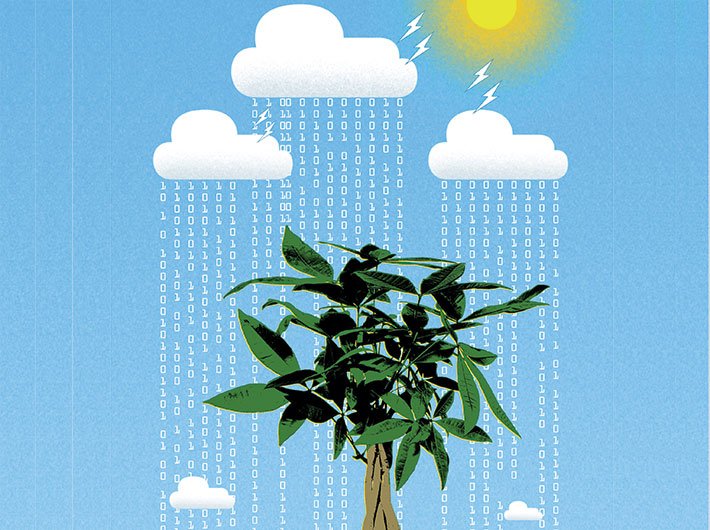A shift from ‘growth’ to ‘sustainability’ is the mantra and technological models like cloud, big data and social media could help drive that transformation
The term sustainable growth is an oxymoron. The connotations of growth are essentially and characteristically in contradiction with those of sustainability.
Historically, all economic growth has come at the cost of environmental as well as social developments, which contradicts the fundamentals of sustainability. Businesses and governments have been so overly focused towards growth that parameters like GDP, revenue and profit have become generally accepted yardsticks to determine if an institution has been a success or a failure.
More and more governments today are making some conscious efforts to make necessary shifts towards sustainability, thanks to the myriad perils of accelerated growth coming to the fore. However, the results have been slow to come by and often inadequate. Be it achieving goals of carbon emission reduction or provisioning night shelters for the urban homeless, there continues to be a lurching shortage. Why?
Arguably, the goals are staggering and the resources required are hardly enough but then have we also considered enough that our sustainability thought processes may be fundamentally flawed? Even worse, they may be distorted – the overarching dominance of growth in our thought processes being the obvious culprit.
The whole notion of growth revolves around creating surplus for the target beneficiaries – be they individuals, companies or governments. And any creation of surplus in one place is likely to create shortages in some other place. If the thriving economies have been firing their growth engines supplied by fossil or petroleum fuels, we know that the ecologies and environments globally have suffered. It’s really a no-brainer.
Growth and sustainability do not go hand in hand. When growth is set to be a goal, sustainability cannot be expected as an outcome.
So governments that truly aspire for sustainability will probably need to find ways to stop making growth-focused plans for economy and instead work to put sustainability parameters at the core of each activity that they do.
I personally have no idea if the dismantling of the planning commission, a primary axis for driving economic growth for decades, has been done with a sustainability agenda as an alternative. However, there indeed lies an opportunity for the government to do so and make the necessary corrections.
Does technology has a role to play in making the necessary correction?
Technologies in general and IT in particular have been leveraged as key catalysts of growth, so much so that we have got ourselves pushed to the verge of sustainability limits in a matter of few decades. Can these technologies also be applied to give a fillip to sustainability-driven governments and societies?
Indeed. Technologies after all are means to an end and not an end in themselves. Depending on how IT technologies are deployed and applied, they could either act as perpetrators of the growth archetypes or emerge as the harbingers of a sustainability era.
Yes, growth is too deeply entrenched across all our economic, social and political ecosystems, so larger-than-life forces would be required to shake things up. From role standpoint, any such changes need to be initiated by no less than the heads of states and institutions. It is no coincidence that the dismantling of the planning commission was done by none other than the prime minister himself.
Transformation-oriented ICT
The shift from growth to sustainability requires an all-round transformation – not only in terms of institutional structures and processes but also in terms of the mindsets and thought processes.
As such, it is essential that the IT and communication (ICT) technologies, employed to achieve the sustainability goals that a government may happen to consider for itself, are chosen with care. It goes without saying that these technologies and paradigms need to scalable, elastic, real-time and contagiously viral so as to bring about a much needed orientation towards the sustainability goals.
In this context, cloud computing, big data, social media, et al are some of the new-age models that readily come to mind. For example, cloud models could be used to rapidly push both government-to-government (G2G) and government-to-citizen (G2C) services in a uniform and ubiquitous manner. Big data and analytics could be used to continuously monitor the impact of those G2G and G2C programs and make necessary refinements – even targeted outreach sub-programmes – seamlessly. Social media channels, along with other digital as well as analogue channels, could be leveraged judiciously to run awareness campaigns, with feedback mechanism interwoven, to ensure that the benefits of the programmes reach the intended groups in a timely fashion.
Sustainable ICT is the key
The footprints of ICT deployments, if not carried out with a sustainability-first policy, can be deleteriously counterproductive to the extent of being self-defeating. For example, cloud data centres or even the ones that power social media data streams could be gigantic energy guzzlers. Some of the large data centres are known to consume as much power as would be sufficient to run entire cities.
It would therefore be important to ensure that the ways and processes in which the ICT technologies are harnessed are designed to be sustainable. For example, if the data centres could be majorly powered by solar or wind energies, that could cut down carbon footprints of these facilities. As a step further, what if these facilities could also produce surplus power that could be routed to grids that power the communities nearby!
Renewable energy also offers an exception – it makes it possible to produce a surplus for all and not for a select few, without an environmental trade-off. It should not be an afterthought when it comes to “ICT for sustainability” and instead should become one of the fundamental premises around which the whole architecture is developed.
This could actually lead to a change in the very basis on which a state data centre location is decided. The stakeholders could consider building clusters of data centres near deserts where solar and wind power are almost perennially available aplenty.
Having said that, why does a state data centre need to be located within the boundaries of a state? It could very well be located in another state where, say, there is no dearth of solar power. The most significant advantage of this would be to rapidly achieve the economies of scale for mega-scale solar power generation and in the process also reduce the dependence of the country as a whole on fossil-fuel powered electricity that accounts for a large chunk of India’s carbon footprint.
A simple step like this towards sustainable ICT could help trigger a virtuous cycle of “green” ecosystem development. For instance, a solar-powered energy surplus could make the electric vehicles more dependable and viable, among other various possibilities.
Sounds like wishful thinking? Well, from a growth-thinking perspective it does; from a sustainability-thinking standpoint it starts looking possible. Also, to reemphasise, for such sustainability goals to be formed and achieved, a country would need no less than a larger-than-life head of state to be the driver.
Kumar is founder analyst at BusinessandMarket.net, a market researcher and strategic adviser with diverse interests.

